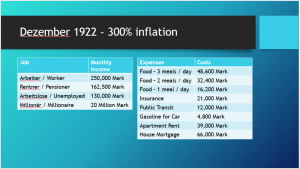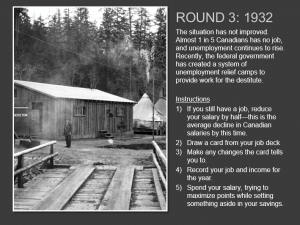Educators contribute to the profession.
As part of a first year class on integrating numeracy across the curriculum, I put  together an activity meant to simulate the experience of trying to pay for the cost of living in Germany during the period of hyperinflation following World War 1. It turned out pretty well in the end, but had no relevance to either of my practicums and I fairly promptly forgot about it. I was thus quite surprised when a classmate informed me that he had mentioned the lesson to a socials teacher at his placement school, and that the teacher in question had expressed an interest in seeing it. I was only to happy to pass
together an activity meant to simulate the experience of trying to pay for the cost of living in Germany during the period of hyperinflation following World War 1. It turned out pretty well in the end, but had no relevance to either of my practicums and I fairly promptly forgot about it. I was thus quite surprised when a classmate informed me that he had mentioned the lesson to a socials teacher at his placement school, and that the teacher in question had expressed an interest in seeing it. I was only to happy to pass  along all the material to a real, live, practicing teacher who actually wanted something I had created. I have no idea if they ever did anything with it, but last I heard everything was printed off and ready to go. I like to think that it’s out there somewhere being shared around the school district. Bonus German language cross-curricular connection!
along all the material to a real, live, practicing teacher who actually wanted something I had created. I have no idea if they ever did anything with it, but last I heard everything was printed off and ready to go. I like to think that it’s out there somewhere being shared around the school district. Bonus German language cross-curricular connection!
During my final practicum, I achieved my goal of having a coaching teacher take something I had created for their own future use in the classroom. By chance, the activity in q uestion was of a similar nature to that of the hyperinflation exercise described above, specifically a simulation of life in Canada during the Great Depression. Not in itself a revolutionary concept, but structuring the activity around decks of cards to randomize events and heighten the drama of the unfolding situation really helped drive student engagement, as did the inclusion of unexpected elements (“first five people to put their wallet on their desk DON’T lose all their money to a bank crash!”). Each turn highlighted a speci
uestion was of a similar nature to that of the hyperinflation exercise described above, specifically a simulation of life in Canada during the Great Depression. Not in itself a revolutionary concept, but structuring the activity around decks of cards to randomize events and heighten the drama of the unfolding situation really helped drive student engagement, as did the inclusion of unexpected elements (“first five people to put their wallet on their desk DON’T lose all their money to a bank crash!”). Each turn highlighted a speci fic topic or theme to do with the Depression that had been previously introduced in the class, and I was quite impressed to see in future assessments that students had drawn some very insightful conclusions and made solid connections based on their experiences during the activity.
fic topic or theme to do with the Depression that had been previously introduced in the class, and I was quite impressed to see in future assessments that students had drawn some very insightful conclusions and made solid connections based on their experiences during the activity.
